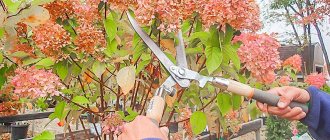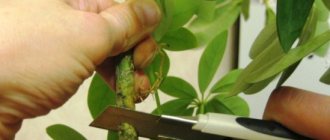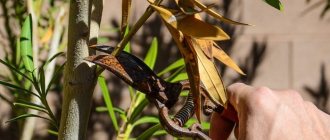Forsythia is one of the most beautiful ornamental shrubs that will delight you with its colorful colors.
In spring it turns golden, strewn with yellow flowers, in summer it is covered with thick green foliage, which turns purple in autumn. Given the rapid growth rate of the crop, one of the most important procedures is pruning forsythia in the spring. It helps prevent thickening of the bush, because forsythia grows many young shoots over the course of a season. In addition, pruning stimulates annual and lush flowering, and this crop has its own characteristics. It blooms in early spring, when most garden plants are just beginning to bloom leaves. And the flowers themselves bloom only on last year’s shoots. On young growth and branches older than 2 years, flower buds do not form. If you do not prune the bush, over time the flowering will move only to the periphery, and most of the crown will be without buds.
When to prune forsythia
Forsythia is a fast-growing ornamental crop. It has the shape of a bush with multiple shoots. Therefore, pruning it is one of the important growing conditions.
Under natural conditions, forsythia grows up to two meters wide and three meters high. But as a landscape decoration, the growth of the bush is limited to 1.0-1.5 m.
Correction of the size and formation of the plant begins immediately after planting.
Forsythia after formation (photo)
Usually the plant is pruned after flowering. This pruning is used for a well-groomed bush.
Pruning before flowering is also possible. It is held in the first ten days of April or the last ten days of March. At this time, the leaves have not yet formed on the branches and the bush is clearly visible. Damaged branches and thickening shoots are clearly visible.
If the forsythia is in very poor condition, you can prune it during flowering.
But such pruning will not bring much benefit to the plant. During this period, it is most vulnerable to diseases and pests. And the cut points can cause the bush to become infected with diseases and harmful insects.
The main pruning of the bush is carried out in the fall, at the very beginning. But you shouldn’t cut out too many shoots. This can significantly reduce the plant's immunity in winter.
If it is not possible to regularly trim the forsythia bush, you can grow special dwarf varieties on your site.
Such bushes grow very slowly, and their height practically does not exceed one meter. Dwarf species require only maintenance and sanitary pruning.
These species do not require annual basic pruning. Shoots are shortened by a third once every three years. If desired, a bush can be formed in the shape of a ball.
Pruning forsythia can seem daunting. But it is quite possible to perform this procedure yourself. Don’t be afraid to spoil the bush, because new shoots grow very quickly.
Expert opinion
Yulia Yurievna
I have a large garden and vegetable garden, several greenhouses. I love modern methods of cultivating plants and mulching the soil, and I share my experience.
Ask a Question
When choosing the time to prune forsythia, it is important to remember that the plant requires a certain period of recovery. When pruning in autumn, the procedure should be carried out at least two weeks before a significant cold snap. When preparing for the procedure, it is important to disinfect and, if necessary, sharpen the pruning shears. For larger and not very young bushes, a lopper and a hacksaw may be required. If large branches are removed, it is better to treat the cut with garden varnish. To prevent the crop from becoming infected with fungal diseases or to prevent softened, rotten areas from appearing on the crown, branches should be removed only in dry weather. It is advisable to choose a time so that there is no precipitation in the next few days. Proper pruning should stimulate the appearance of growth and abundant flowering, and improve the health of the plant. In conditions of a thick crown, when not all branches receive enough sunlight and the air circulates poorly, diseases develop more often. During the pruning process, it is important to take into account that the described bush blooms only on last year’s branches. Their intensive removal will reduce the decorative effect of forsythia.
Care after pruning
After the crown has been formed as a result of spring care, forsythia is fed and the roots are ennobled. Immediately after winter, the bush is mulched with humus and then watered.
Pruning jasmine after flowering and to form a bush
When the shoots become covered with buds, mineral fertilizers are applied, and after flowering - nitroammophoska and selenium. At the end of summer, the bush needs potassium and phosphorus. During the warm period, there is a need for careful control of soil moisture. If precipitation occurs frequently, then additional watering is not needed. In dry weather, the soil is moistened.
After autumn pruning, moisten the substrate where the forsythia grows, insulate the roots with pine needles and rotted leaves in a volume of 10 cm.
Attention! If you properly fertilize and insulate the plant, this will give it the strength to survive the winter and bloom next year.
If the bush does not bloom in the spring after the autumn growth correction, this is not necessarily due to incorrect technology. Perhaps the optimal planting location for forsythia has not been selected, or fertilizers have not been applied in a timely manner. The bush loves places with good lighting, but without excess moisture.
How to prune a forsythia bush correctly
Pruning forsythia depends on the purpose of its cultivation. Bushes are usually planted as a separate decorative element in landscape design or as a bright hedge.
If the plant is formed as a single bush, the first pruning is carried out after planting it in open ground. All weak shoots are removed. In the first 2-3 years, pruning such a plant consists of removing frozen and damaged branches at the root.
Next, the main pruning is carried out in the summer. Faded branches are shortened by half. All damaged shoots are cut out at a level of 6-7 cm from the ground. This is necessary to thicken the plant. Subsequently, young shoots form on these stumps.
The main stages of pruning a plant:
- Removing ¼ of all old branches at the root
- Cutting out dead branches
- Trimming faded branches
- At the last stage, the bush is given symmetry or an original decorative shape.
Forsythia blooming (photo)
When planting a hedge, no pruning is carried out in the first 2-3 years. The plant must send out many long shoots, which subsequently intertwine with each other.
This creates a dense corset of flowering branches. Then sanitary pruning is carried out annually. It removes all damaged branches, as well as dead and dried shoots.
Forsythia is highly resistant to diseases and pests. But if, during flowering, twigs damaged by insects or any infection were found, it is recommended to cut them out and burn them.
Afterwards the bush is treated with special chemical or biological solutions.
During summer and autumn pruning, you can prepare material for propagating the bush. In June, green cuttings 15-20 cm long are cut and planted in a greenhouse.
In September, strong branches are selected and cuttings 10-15 cm long are prepared. They are planted directly into the ground, leaving 3 buds above its surface. For the winter, such seedlings must be covered.
Basic information and technology
Formative pruning should occur in the second year after planting the bush, since the initial pruning is done in the first year. In general, it should be noted that this is a long-term event, and it stretches over several years. Every year, several more shoots are added to the main branches of a small bush. Usually choose up to 3 strongest gains.
You need to strictly monitor the shape, immediately removing excess branches, as there is a high risk that it will bend. But there is also no need to go to extremes, since excessively strong pruning will lead to the bush looking bare and loose. First, always remove all weak shoots that will come from the roots, as well as those directed into the bush. You can leave only those that will subsequently replace damaged and diseased shoots.
Comments (4)
Peter
01/13/2018 at 12:01 |
The blooming forsythia in the pictures is so gorgeous! And my branches freeze slightly every winter, so it only grows in width. Trimming doesn't help with this. It's a shame. This year I will try to transplant it to another place and cover it for the winter.Answer
Yulia Expert Plodogorod
07/02/2019 at 19:58 |
Hello, Peter! To avoid such difficulties when growing the described shrub, you need not only to properly prepare it for wintering, but also to observe the peculiarities of care in the autumn.
To begin with, we recommend performing autumn pruning of the bush. First of all, dry branches are removed, those with cracked bark, thickening the crown and too long shoots.
Afterwards you need to remove shoots that are too close to the ground. You can leave such branches only if you plan to propagate by layering. You can also remove branches that are located very close to each other, as well as those that grow inside the crown. Additionally, you can remove anything that spoils the overall appearance of the bush crown.
It is better to carry out the described measures without waiting for a cold snap; you can prune the forsythia a few weeks after the end of flowering. We would like to note that this is not only a general sanitation of the bush. This procedure improves the winter hardiness of the bush.
As for shelter during the cold season, we recommend covering even frost-resistant varieties of this plant. 10-15 days after the end of flowering, it is better to water the forsythia abundantly and also feed it with potassium. These measures also contribute to better resistance to cold.
Before preparing for shelter, the soil around the bush is mulched with a thick layer. You can use peat or old sawdust. If the plant is not very large, the branches can be carefully bent to the ground and secured there with pins. Afterwards, the bush should be covered with agrofibre and secured around the perimeter either with pins or heavy stones.
If the plant is very large, then bending it to the ground runs the risk of damaging the shoots. Therefore, in this case it is better to make a frame around the plant and cover it with the same spunbond. You can use a chain-link mesh and wrap it around the plant. We do not recommend using polyethylene film for covering.
If you decide to feed the plant in the autumn, you need to choose products that do not contain nitrogen. You can also treat both the bush itself and the soil near it with drugs against diseases and pests. After all, it’s not uncommon for these uninvited guests to settle down for the winter simply in the crown or tree trunk circle.
Answer
Angelina
12/01/2019 at 01:14 |
I couldn't get my forsythia to bloom thickly in the spring. A friend advised me to completely renew the bush - cut all the stems as low as possible, almost to a stump! I did just that in August. New young growth has begun to sprout in spring! Now it's blooming well! And I start cutting it, forming a circle.
Answer
Yulia Expert Plodogorod
12/01/2019 at 21:42 |
Hello, Angelina! It is important to know what type of forsythia grows on your site. This will help determine what type of pruning is required because, for example, the rules for pruning dwarf and vigorous bushes of this crop are significantly different. In general, if the plant was old enough, such radical rejuvenation can help.
In addition to formation, we recommend not to forget about sanitation. It is important to remove weak, crown-thickening, dried, deformed and broken shoots. Also, in spring there may be frozen shoots. All these branches need to be removed to protect the bush from diseases and the development of pests.
Although forsythia tolerates pruning well, we recommend not removing more than 30% of the entire green mass at one time. This does not apply to cases when it is necessary to remove infected branches.
Also, before trimming such a bush, it is worth considering what shape it needs to be given. You can even use special templates to form bushes.
We would like to note that sometimes flowering is poor or absent due to a lack of nutrients in the soil. The first fertilizing is carried out in early spring. You can use rotted organic matter. Next, before flowering, we recommend applying mineral fertilizer with a predominance of phosphorus and potassium. After flowering, you can repeat the application of mineral products.
Additionally, we recommend that you always use only clean and sharp tools. This will help protect the tissue from infection in the wounds and additional injuries when trimming with blunt equipment.
Answer
Required Tools
To trim shrubs, including its decorative dwarf varieties, you need a well-sharpened, sharp tool that should leave even cuts. Before and during cutting, it is important to disinfect the metal with suitable antiseptics. If you use a dull, dirty blade, fungus or other infection may develop at the cut site, which is dangerous for forsythia.
The main tools required for the work are garden pruners and a hand saw for wood or a lopper , shaped like scissors with long handles and considered the most convenient for such work. A hacksaw is needed if you decide to trim thick, large branches. Before the procedure, you should make sure you have a garden varnish: it is used to smear large cuts that form on shoots 1.5 cm thick. The cut material should not be thrown away: it can be useful as mulch, for high beds or compost. It is wiser to burn branches affected by the disease to protect the rest of the plants in the garden.
Pruning - both in spring and summer, and in autumn - should be carried out in the absence of sunlight, on a cloudy day, preferably during rain - this will eliminate ultraviolet burns and the penetration of pathogenic flora.
Features of planting and caring for forsythia in Siberia
If you plan to plant forsythia in Siberia, then it is necessary to provide the shrub with proper care, this is the only way the plant will delight with its appearance. In Siberia, forsythia is planted in places with little shade. It is also necessary to ensure that the site chosen for planting is protected from the wind. Often shrubs are planted near buildings or trees.
Soil enriched with microelements is ideal; humus is usually used for these purposes. Stagnation of moisture is not allowed, so the soil must be loose and well-permeable to air. If the soil is acidic or heavy, then it should be prepared in advance for planting forsythia.
Attention! If you do not provide proper care and allow groundwater to stagnate, the forsythia may die.
Features of planting and caring for forsythia in the Urals
For each region, there are certain conditions for growing shrubs, so it is necessary not only to familiarize yourself with the photo of forsythia, but also with the rules of planting and care in the Urals. In the Urals, shrubs are planted in light soil, which is rich in humus and leaf soil. To lighten the soil, you can use expanded clay or river sand. It is important to understand that forsythia does not tolerate acidic soils.
The planting depth is about 70 cm, drainage up to 20 cm high is laid at the bottom of the hole, for this they use:
- broken building bricks;
- middle fraction expanded clay;
- sand.
To make the shrub grow faster, use top dressing and fertilizers, which are applied in the spring. Forsythia loves dry soils, so it is not recommended to overwater it.
Advice! The distance between bushes should be 2 m.
Rosemary
This shrub, which emits an incredible aroma, can be found not only in gardens, but also in vegetable plots. Its greens are widely used for culinary purposes. As for the flowers, they must be removed at the beginning of summer, after they have faded. The entire peduncle must be cut.
An older rosemary bush can grow wildly. In this case, at the beginning of spring it should be subjected to formative and rejuvenating pruning. You need to remove all weakened shoots and those located close to the ground. To rejuvenate overgrown specimens, the branches must be shortened by half.
6.Transplant
It is not recommended to change the location of adult plants; in addition, many forsythia exceed 1.5 - 2 m in height and replanting them is simply difficult.
Of course, it is better to immediately plant a shrub in a permanent place, but young plants up to 3-4 years old, if necessary, can be transferred to a new place after complete flowering - at the end of spring.
It is better to transplant on a cool and cloudy day - in such conditions it will be easier. The bushes are dug around the perimeter, making a circle equal to the diameter of the crown - this is the distance the root system diverges.
↑ Up,
In order to reduce moisture loss, some of the branches are removed using pruners. The bushes are dug up together with a lump of earth, laid on burlap or film to keep the root ball intact, and transferred to a new area, being careful not to destroy it - they are transferred. Transshipped specimens adapt faster and begin to grow. IN
In the first week after transplantation, it is advisable to provide shelter from direct sun and promptly water the disturbed bushes. In the first winter after transplantation, shelter will be mandatory for such forsythias.
↑ Up,
Lilac update
Do I need to prune lilacs after rejuvenation? Next year, after radical rejuvenation, begin the lilac renewal cycle. After the first growing season, shoots should be thinned down to two-thirds of the healthiest shoots to prevent the same problem from occurring too quickly.
Once your lilacs begin to bloom again, they should be pruned as soon as they bloom. Every third of the tallest stems can be removed at the base to maintain fresh growth and a compact bush.
You can also choose a less drastic method of renewal instead of rejuvenation if you don't want to leave a "hole" in your landscape while the lilac grows out of the ground. For a simple update, you would simply delete one third of the oldest branches every year for three years.
Quince formation
Formative pruning of quince is the most difficult, so we will talk about it in as much detail as possible. The formation of quince begins from the first year of the seedling’s life. Usually the top of a one-year-old seedling is removed; the total height of the seedling after its removal should be 60 cm.
Photo: The thick crown is strewn with fruits
How to shape quince by season
First season
Quince varieties can be tall or short. Usually, for a tall one, the type of crown chosen is cup-shaped, and for a short one, a sparsely tiered crown is chosen - up to 10 branches.
- First, determine the angle at which the shoots depart from the trunk; the blunter it is, the better. All shoots whose angle of departure is less than 45 degrees, that is, 40-30 and so on, must either be bent to an obtuse angle or removed completely.
- Leave a distance of 12-15 cm between the shoots; they should not be denser.
- If we are talking about shoots of the upper and lower tier, but not the center of the crown, then the distance can be safely increased to 25-30 cm.
- Be sure to shorten all skeletal branches to a length of 60 cm; make cuts on the outer bud, that is, the one that “looks” outside the crown, and not inside.
- Shorten all weak shoots so that no more than 2-3 buds remain on them.
There should be no shoots on the trunk up to a height of 20 cm from the ground; during the same period, all shoots can be removed.
Photo: Sparsely-tiered crown type
Second season
In the second season, the formation continues. It is necessary to shorten all too long shoots (longer than 50 cm) by a third, remove vertical ones, competing shoots and those that may appear on the trunk. The main pruning is carried out in annual increments.
Season three
Usually, over the past two seasons, a correctly formed tree already has about 7-8 skeletal shoots by the third season. This is already a fairly strong tree, so now it’s worth removing those shoots that interfere with normal ventilation and lighting in the center of the crown. It is also necessary to transfer the central conductor to the side branch, cutting it to the outer bud.
Season four
It is necessary to correct the overgrowing shoots. All those that you think are appropriate and necessary for the plant should be shortened by 3-4 buds. If the shoots are very short, less than 20 cm, then you should not touch them, of course, if they are located correctly - they are not tops, competing shoots, and so on.
Pay attention to the longest ones, whether they stand out from the overall picture of the crown. If this is observed, then such shoots must be shortened to eliminate the sloppy crown effect.
Season five onwards
Here the basis is already corrective, sanitary and then rejuvenating pruning.
It is also necessary to remove shoots that are five or more years old.
If you get an old tree, then prune it partially, removing about a third of the required volume of excess shoots, no more.
All cuts and saw cuts, at any time of the year, must be immediately insulated with garden varnish or garden paint.
Photo: Vary is an effective means for healing and disinfecting branch cuts
After pruning in the spring, it is necessary to apply complex fertilizer - nitroammophoska, a teaspoon for each tree. In summer - half a teaspoon of potassium sulfate and superphosphate in pre-watered, loosened soil. ___________________________________________
Interesting read: 10 mistakes gardeners make when caring for fruit treesChaenomeles, or Japanese quince ___________________________________________











